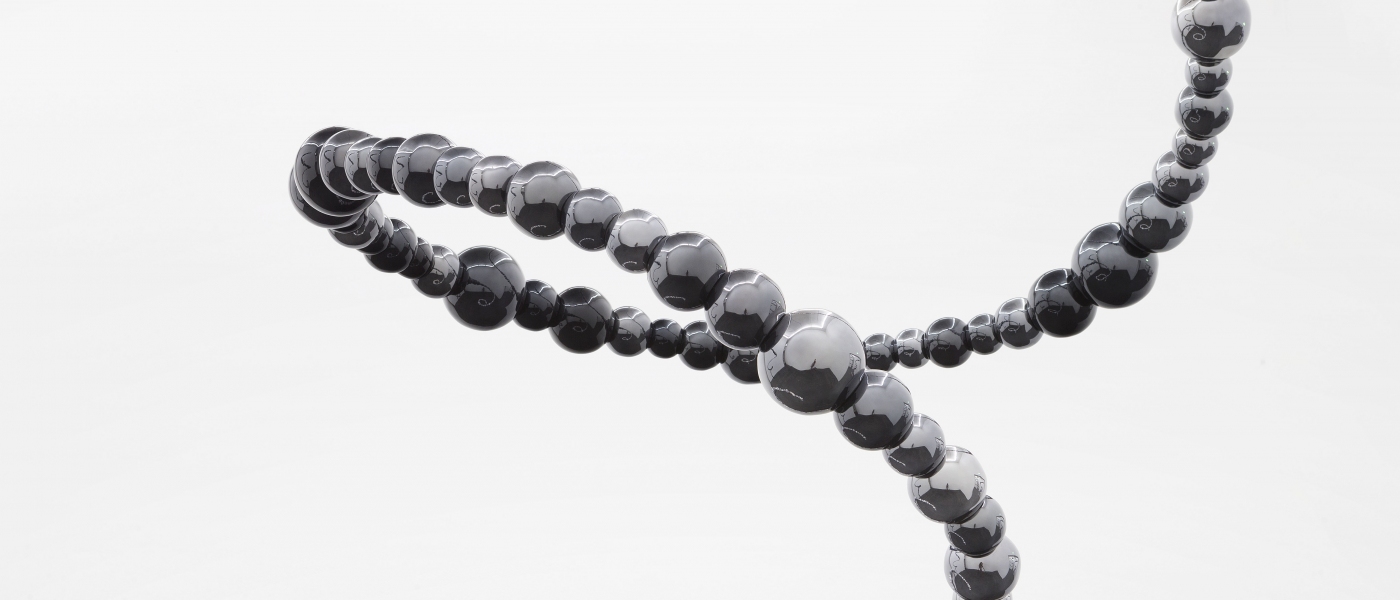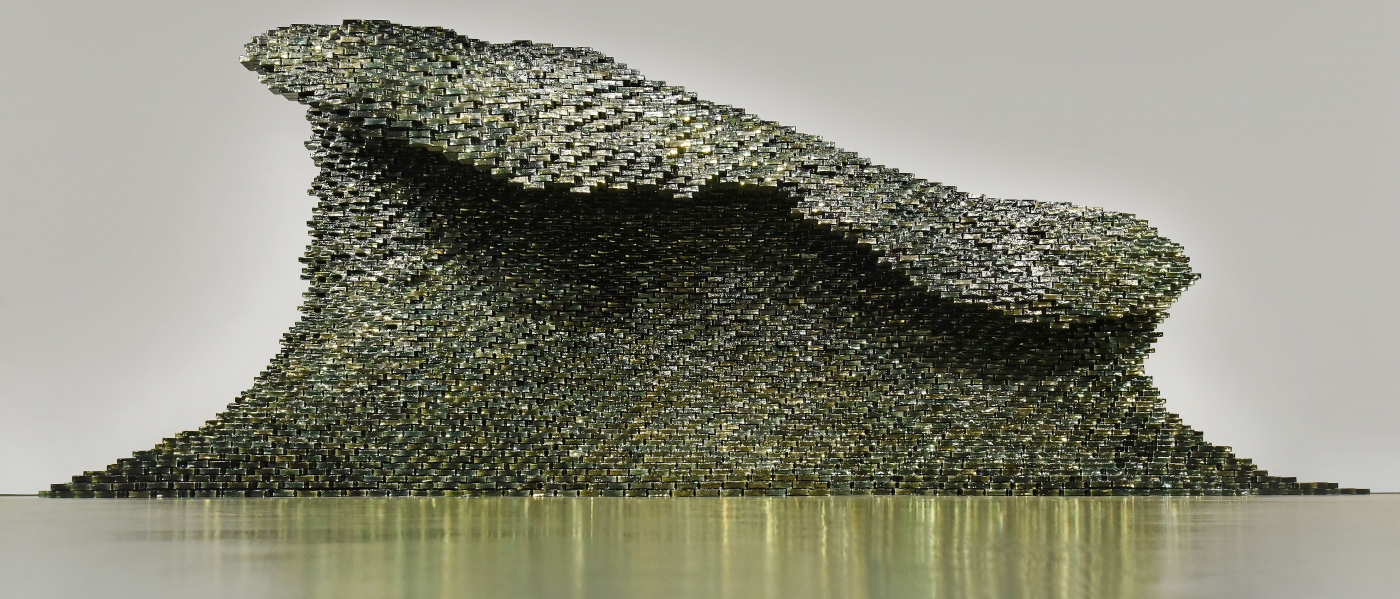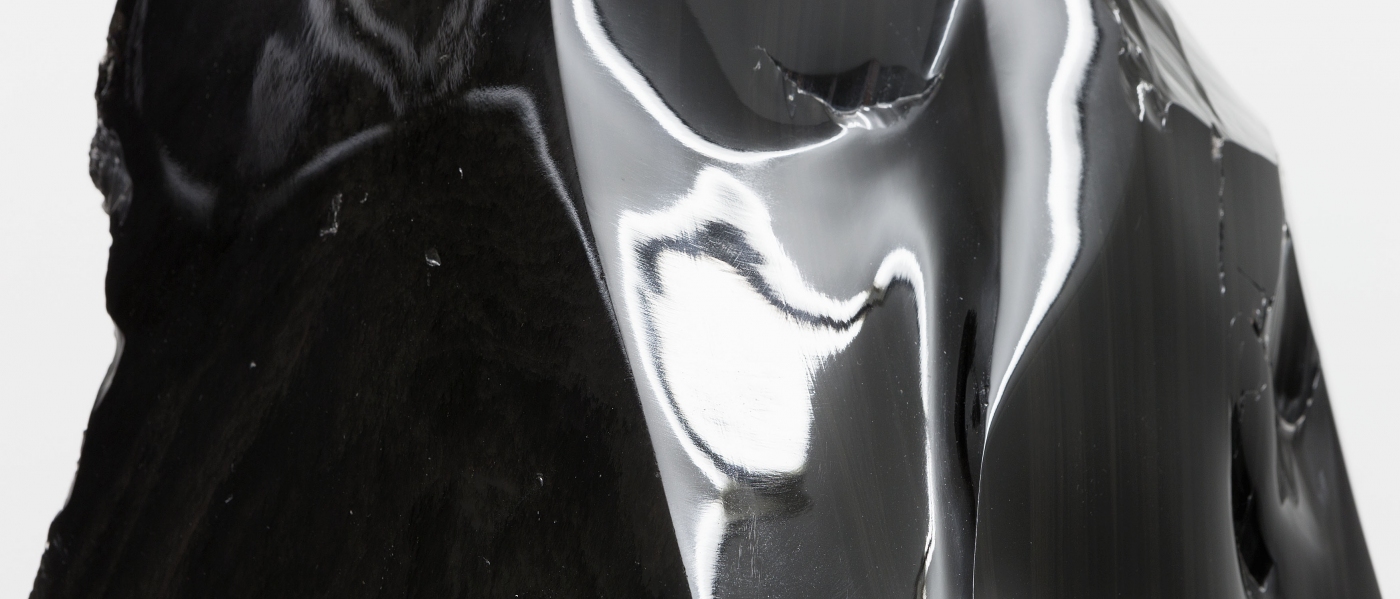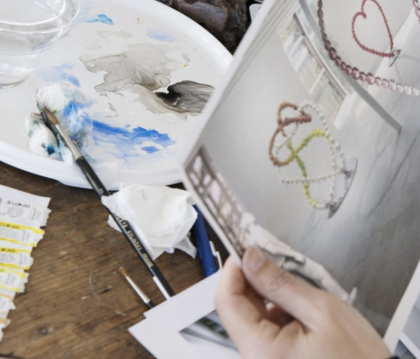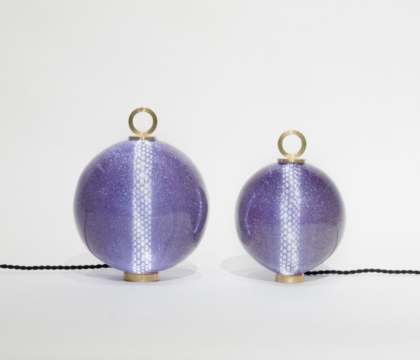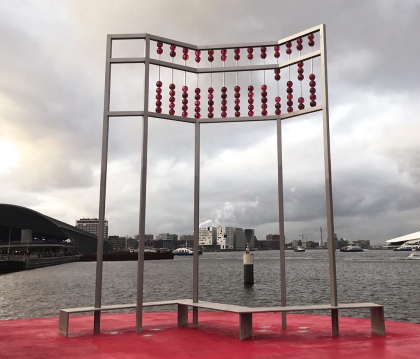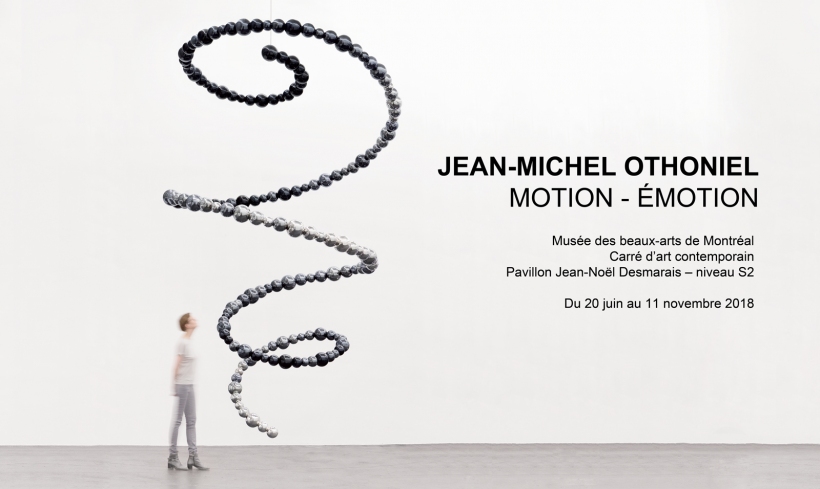
MOTION - ÉMOTION
June - November 2018, Musée des Beaux-arts de Montreal
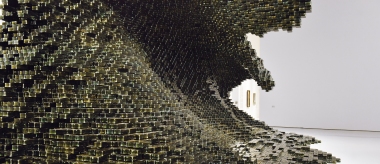
Face à l'obscurité (Facing Darkness)
May - September 2018, MAMC Saint-Etienne
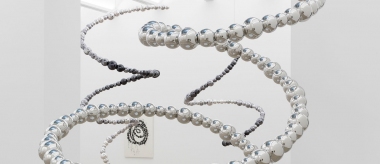
DARK MATTERS
March - April 2018, Galerie Perrotin New York
MOTION - ÉMOTION
June - November 2018, Musée des Beaux-arts de Montreal
Discover the exhibitionMOTION - ÉMOTION
The elements and the shapes of nature have always been a source of inspiration for Othoniel. Here, however, the artist has selected sculptures and paintings that depart from a feeling of wonderment and reflect instead his preoccupying concern for the environment in works with a darker side.
Nathalie Bondil, Director General and Chief Curator, MMFA, explains: “Seeing Jean-Michel’s latest production during a recent visit to his Paris studio, I wanted to invite him back to the Museum. I was impressed by the graphic power of his tornadoes and waves… a humble homage to mighty Nature and the violence of the elements in these precariously balanced sculptures.”
His monumental Tornadoes in chromed aluminum or mirror-polished stainless steel, four of which are suspended in space like mobiles in the Contemporary Art Square, surround the viewer as they approach them. Through their twisted motion and imposing size, they evoke the violence of the elements. The reflective surfaces that characterize most of Othoniel’s works engage the viewer in a dialogue with architecture and the environment. As they get close to the sculptures, viewers see their reflections infinitely multiplied. These gigantic mirrors can thus be seen to reflect our personal fears and desires.
The artist wanted to take this idea even further for the Montreal exhibition: To keep his Tornadoes moving, he mechanized them with the help of engineers. In doing so, he integrated a fourth dimension to his sculptures – movement. His suspended Tornadoes rotate in space and move as people pass by. Instead of the tornado blowing people over, it is the people around the tornado who set it in motion.
Jean-Michel Othoniel makes no secret of the fact that the kinetics of American Alexander Calder’s mobiles have been a major source of inspiration for him. Incidentally, the MMFA will be exhibiting Alexander Calder: Radical Inventor from September 22, 2018, to February 24, 2019. “I’m very pleased and honoured that an exhibition on Calder is being presented at the same time as mine. This will be my first ‘discussion’ with the artist, in which our mobile sculptures engage in dialogue at the same time in the Museum. Calder remains the master of the mobile and reinventing it is a true challenge,” says Othoniel.
Face à l'obscurité (Facing Darkness)
May - September 2018, MAMC Saint-Etienne
Discover the exhibitionFace à l'obscurité (Facing Darkness)
See publication
This is the third exhibition the museum has devoted to the artist and the first of such importance.Specifically conceived for the MAMC’s 30th anniversary, it marks a turning point in the work of the artist with the presentation of works which are darker and more intimate, but still just as poetic and mysterious.
Saint-Etienne is the birthplace of Jean-Michel Othoniel and the city of his childhood. At the age of 6 he attended introduction to art classes at the “Maison de la Culture”; at 7 years old he signed up for guided visits at the Museum of Art and Industry and between the ages of 9 and 17 followed evening classes at the School of Fine Arts. Having obtained a High School certificate in plastic arts in 1981 he left his home town for Paris.
Jean-Michel Othoniel has never concealed his passion for the Museum of Modern and Contemporary Art, a living space and one of enchantment. The Museum and its collections form the source of his vocation as an artist.
“It is thanks to the Museum that I became an artist. I remember when I was 7 years old being struck by the works of Robert Morris and minimal art, their formal simplicity masking a
whole thought process of the purity of contemporary art”.
Facing darkness
The works exhibited in central hall of the Museum all refer to the artist’s worried and anxious vision of the world. By revealing works which are very closely linked to features of his home town, Jean-Michel Othoniel raises questions about our presence in the face of global change. In an autobiographical journey his older and intimate works converse with his latest architectural and telluric creations. Placed at the four cardinal points of the central exhibition hall, the works interchange and enter into dialogue.
Experiencing darkness
The centrepiece of the exhibition is the large panel of dark glass in the form of a wave, specifically designed for this space. The Big Wave, began in Sète in the summer of 2017, is transformed here into a wall of menacing black bricks, a cave or a cavern. Othoniel is paying homage to memories of the walls in his town, formerly blackened by coal dust. Physically confronted by this wave we experience a feeling of being consumed by darkness, engulfed in the reflections of the dark black matter. In the face of an apocalyptic reality of unleashed elements, this crashing swirling structure, 6 metres high and 15 metres long, takes on the presence of a tidal wave, and the colour of an oil slick.
Facing childhood monsters
In this former blackened city, the grim slag heaps still made the child artist dream. In 1996, when invited to exhibit at the Mining Museum in Saint-Etienne for the “Art in the City” event, he presented a filmed performance in which he transforms a black slag heap into an erupting volcano. He was staging his vision of a spell bound child. This short poetic film will be presented in the exhibition: a child in the face of darkness, conjuring up monsters from the past, transforming shadows into luminous gems and the volcano’s smoke into fireworks.
The darkness within us
In contrast to the gigantism of the wave, the other key work of this exhibition is a minute photograph depicting the artist facing the obscurity of an uncertain future. The minuscule Self-portrait in priest’s vestments timidly reveals another of Othoniel’s performances produced in1986, a period when the artist was undergoing an existential crisis: to live or to die, leave the secular life, become an artist. As if to hide and to transform himself the artist returned to the region of his birth to produce this first performance, disguised as a priest. This very first work was carried out in Cotatay, not far from a miraculous cave: a photograph taken from the rear in which he confronts the wall of a frozen dam and tries indefatigably to climb the icy face.
This first image condenses the major themes and elements making up his work: the selfportrait, mystery, the transition from shadow to light, finesse and obstinacy, a game, a secret, risking danger, solitary pleasures, joy, the instantaneous and the unique, the importance of “off-camera”, conveyed narration, the sacred, the predominance of the elements, the desire for enthrallment, ghosts and poetry, the wish to be submerged.
Face to face
In one corner of the hall, Jean-Michel Othoniel presents his very latest works in glass, Invisibility Faces, set out in blocks of obsidian, like mysterious totems. They are selfportraits sculpted in the black glass of Armenian volcanoes. Placed on chestnut wood pedestals carved by anthroposophical woodworkers from Dornach in Switzerland, the energy of these enormous stones of vitrified lava converses with that of the wood. These dark masses, resembling meteorites fallen from the sky, sculpted by the artist with the help of his glassmakers, absorb the light, allowing a pale reflection of our own image to show through.
Reminiscent of Giacometti’s Cube or the dodecahedron of Dürer’s Melencolia I, these “calm blocks here below, fallen from an obscure disaster”1 become a homage to the blackened faces of miners, the “gueules noires” (black-faces) of his childhood.
The artist and the Museum of Modern and Contemporary Art
This audacious radicalism, presented very early on by the Saint-Etienne Metropolitan Museum of Modern and Contemporary Art, endures in Othoniel’s current work. With his latest almost monochrome works, he seeks the purity of form inspired by nature and even a certain form of abstraction. The artist is attempting to express a desire for violent enthrallment which is minimal and telluric.
The Museum supported the works of Othoniel from his beginnings, with the acquisition for its collections of an emblematic work from his “Soufre” (Sulphur) period, entitled the Hermaphrodite, along with his phosphorous paintings in homage to the Fiancé by Picabia. With “In the face of darkness”, Othoniel returns to Saint-Etienne to reveal his latest works in glass, the fruits of his present research into the purity of form, monumentality, monochrome and radicalism. The historical works of the artist presented in the exhibition, produced towards the end of the 1980’s, show both the genesis and the constant renewal of themes dear to the artist, which like successive waves, continue to submerge him.
DARK MATTERS
March - April 2018, Galerie Perrotin New York
Discover the exhibitionDARK MATTERS
Opening March 3, 2018, 4pm - 8pm
March 3 – April 15, 2018
Perrotin New York is pleased to present “Dark Matters”, Jean-Michel Othoniel’s 7th solo show at the gallery. With an ensemble of new and original works, some specially created for the occasion, the show spans several levels of the building to mark the inauguration of the whole building at 130 Orchard Street. « Dark Matters » is the title of the text written by the French-American curator, writer and critic Natasha Boas, within the eponymous book published on the occasion of the exhibition. A prominent artist on the French and international art scene, Jean-Michel Othoniel prefers materials with poetic and sensitive properties. From an exploration of drawing and sculpture, to installation and photography, writing and performance, he began working with glass, now his signature material, in the 1990s. Exhibited around the globe, Jean-Michel Othoniel is a wild artist beyond compare, who questions how to live in today’s world through works in which beauty is no longer an aesthetic element, but a condition of existence.
Wild Knots
The artist’s latest creations in New York are characterized by the figure of the oxymoron, bringing together the monumental and the fragile, the austere and the marvelous, minimalism and baroque. All of the elements brought into play—glass, mirror, metal, ink, white gold—pertain to this desire for violent, minimal and telluric enchantment, contrasted today with the sorrow of the world. In Othoniel’s enchanted world, heaven and hell have the same face: one of a phantasmagorical universe over which the pain and judgment of our human realm have no hold. The phantasmagoria receives and unifies opposites, be they moral judgments (good and evil) or aesthetic divisions (beautiful and ugly, abstract and figurative). It attains the artistic fulfillment sought by the Romantics. Schelling said that art was the resolution of an infinite contradiction in a finite object (1). An awareness of the infinity of contradictions, which has marked the artist’s oeuvre from the start, finds fulfillment here in an understanding of art as a mechanism of phantasmagorical investment. In doing so, he takes up the radical stance that influential artist James Lee Byars brought to the contemporary art scene. Byars responded to endless doubts with a quest for perfection that took him to the outer limits of art: the total transformation of the world into an object of contemplation, then, as a final step, the proposition of art as the only truly habitable world for the human spirit. Othoniel develops in his own language a conception of art as “a world in which to live”(2) an expression Gianni Vattimo used in reference to Byars ; a conception that can only materialize in a work in which beauty is no longer an aesthetic element, but a condition of existence.
Beauty and its reflections
Mixing polished metal with mirrored glass, the works in this new show are devoted to storms and the violence of the elements. The central pieces, a spring gushing forth from a blue grotto and gigantic tornadoes spinning like mobiles, are surrounded by walls of mirrored bricks, cascading necklaces and large suspended glass beads knots. The sculptures seek the violence of shapes; they demonstrate the perfect balance of hanging ellipses and the reflections between them. The artist also draws from his fascination for observing the mathematical combinations of reflections endlessly multiplied, which gave rise to a dialogue with Mexican mathematician Aubin Arroyo. The images he develops in his research echo the reflecting sculptures that Othoniel created in homage to Jacques Lacan. This encounter between sculpture, psychoanalysis and mathematics inspired their book, Nudos Salvajes (3) to be published in December 2017. At the same time, a piece by Jean-Michel Othoniel, The Infinite Knot, entered the Institute of Mathematics collection at the University of Mexico. As Aubin Arroyo explains, “up until today, mathematicians have cataloged more than one and a half million different knots, starting from the simplest one towards the more complicated, and the catalog is still growing. However, the attempt to order all the existing knots in such a catalog can never be completed. This catalog only considers a class of knots called tame knots. A knot is tame if it can be constructed with the cord of a string formed by a finite number of beads, or pearls. There also are some knots that will never satisfy this property. These knots are called wild knots (4).”The Surrealists were fascinated by mathematical objects and shapes. They found something inherently poetic in their abstraction, which we tend to see as random and disconcerting. These linear shapes, schematic translations of thought that start from the simplest to reach the complexity of logical formulation, are the very expression of the mystery of shape. Indeed, no one doubts they hold meaning, esoteric to the average person, but essentially clear and demonstrative. Visualizations of a theory, a hypothesis, a system, they inscribe pure thought in space. In mathematical objects, the eye perceives something beyond the shape, an abstraction that is not disincarnation, but quite the opposite, a material expression of the immaterial. “A knot diagram can be thought of as the projected shadow of the knot over a plane surface (5).” These projected knots the mathematician refers to are a perfect description of Othoniel’s paintings on display in the new Perrotin exhibition space. They are abstract figures, but based on observation of nature and its shadows. They invade the canvas like spurts of ink, a cold gesture that brushes the surface covered with white gold leaf. Like stained and frozen icons, these paintings are placed around the sculptures of black, amber and purple mirrors. This series of works on canvas shows the importance of drawing, suspended movement and the distanced body in Othoniel’s work. Is the first painting not merely the shadow of a lost lover?
A new architecture of glass
“The face of the earth would be much altered if brick architecture were ousted everywhere by glass architecture. It would be as if the earth were adorned with sparkling jewels and enamels (6)” For all his apparent rigor, Othoniel is, like his knots, wild. Free to drop everything and travel to India for several months to explore the country’s glassmaking tradition. This trip was the only way for him to work in Firozabad, an Indian city famous for its glassworks, where he learned the age-old techniques of the local craftsmen. He observed them working right on the floor, as close as possible to the materials and the furnaces. These moments of creation, born of this close physical contact between the molten glass and the glassblower suffering in the sweltering heat, moved him deeply. India changed everything he thought he knew about glassmaking. Ever since this memorable experience, he has created giant walls of glass bricks built using Indian techniques. These abstract, monochrome works stem from his observation of the bricks piled up along the roadsides of India. The artist saw these brick monoliths as monuments bearing the hope of their owners, a symbol of their dreams to one day build their own homes. Today in New York, Othoniel exhibits his Precious Stonewalls, sculptures bordering on radical architecture. These walles-in spaces, his Blue Brick Road of 17 meters long and his Grotta Azzurra pay a poetic homage to the historic Stonewall demonstrations on Christopher Street and condemn the silence that still threatens the meaning of this worldwide march that began in NYC in the beginning of the 70’s.
The marvelous real
This desire for gatherings, architecture and utopic monuments that foster dialogue and encounters is something the artist would like to reflect upon throughout his exhibition with the students of NYU and the support of the Public Art Fund.By converting one of the gallery rooms into a workshop, he would like to raise the question that haunts him today at a time when the world seems to be falling apart: how can we re-enchant the world? He wonders what happened the day after the Tower of Babel fell and millions of bricks were left scattered on the ground. What did the people do? What did they rebuild and what should we rebuild in their wake?
